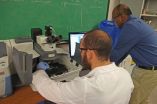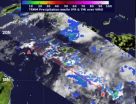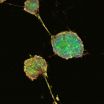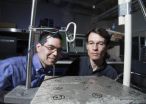(Press-News.org) Get ready for a fascinating eating experience in the center of our galaxy.
The event involves a black hole that may devour much of an approaching cloud of dust and gas known as G2.
A supercomputer simulation prepared by two Lab physicists and a former postdoc suggests that some of G2 will survive, although its surviving mass will be torn apart, leaving it with a different shape and questionable fate.
The findings are the work of computational physicist Peter Anninos and astrophysicist Stephen Murray, both of AX division within the Weapons and Complex Integration Directorate (WCI), along with their former postdoc Chris Fragile, now an associate professor at the College of Charleston in South Carolina, and his student, Julia Wilson.
They came up with six simulations, using the Cosmos++ computer code developed by Anninos and Fragile, which required more than 50,000 computing hours on 3,000 processors on the Palmetto supercomputer at Clemson University in Columbia, South Carolina.
Previous simulations of the upcoming event had been done in two-dimensions, but the Cosmos++ code includes 3D capability, as well as a unique "moving mesh" enhancement, allowing the simulation to more-efficiently follow the cloud's progression toward the black hole.
The black hole is known as Sgr A*. "Sgr" is the abbreviation for Sagittarius, the constellation near the center of the Milky Way. Most galaxies have a black hole at their center, some thousands of times bigger than this one.
"While this one is 3-to-4 million times as big as our sun, it has been relatively quiet," according to Murray. "It's not getting fed very much." Contrary to their name, black holes can appear very bright. That's because gas orbiting them loses energy via friction, getting hotter and brighter as it spirals inward before falling into the black hole.
The composition of the G2 cloud is still a mystery.
Astronomers originally noticed something in the region in 2002, but the first detailed determinations of its size and orbit came only this year. The dust in the cloud has been measured at about 550 degrees Kelvin, approximately twice as hot as the surface temperature on Earth. The gas, mostly hydrogen, is about 10,000 degrees Kelvin, or almost twice as hot as the surface of the sun.
Its origin is still unknown.
Murray says: "The speculation ranges from it having been an old star that had kind of a burp and lost some of its outer atmosphere, to something that was trying to be a planet and couldn't quite manage it because the environment was too hot."
As the cloud approaches the black hole and begins to fall in to what Murray describes as "a gravity well" beginning next September, it will begin to shed energy, causing it to heat to incredibly high temperatures, visible to radio and X-ray telescopes on Earth as well as orbiting satellites such as NASA's Chandra X-ray Observatory.
But it won't be a collision course.
The point at which a stellar object can no longer escape being swallowed by a black hole is known as the Schwarzschild radius, a quantity whose value depends on the black hole's mass, the speed of light and the gravitational constant.
The cloud will actually pass far enough away that it will escape the point of no return by approximately 2,200 Schwarzschild radii, which in this case is about 200 times as far as Earth is from the sun.
But the supercomputer simulations show that the cloud will not survive the encounter.
According to Anninos: "There's too much dynamical friction that it experiences through hydrodynamic instabilities and tidal stretching from the black hole. So a lot of its kinetic energy and angular momentum will be dissipated away and it will just sort of break up into some sort of incoherent structure. Much of it will join the rest of the hot accretion disk around the black hole, or just fall and get captured by the black hole. It will lose a lot of its energy but not all of it. It will become so diffuse that it's unlikely that any remnant of the gas will continue on its orbital track."
The close encounter will take several months. The entire event is predicted to last less than a decade.
The simulation is posted on the Web at: http://fragilep.people.cofc.edu/research/cloud.html
It shows the cloud modeled as a simple gas sphere, near the point in its orbit where it was first discovered. As it approaches Sgr A*, a process known as tidal stretching increasingly distorts the cloud. By the end of 2012, the cloud will be nearly five times longer than it is wide.
Along with tidal stretching, the cloud also experiences resistance in the form of ram pressure as it tries to plow through the hot interstellar gas that already fills the space around Sgr A*. The interactions of G2 with this background gas cause further disruptions to the cloud from Rayleigh-Taylor and Kelvin-Helmholtz instabilities. Collectively, these effects act to strip some material from the cloud and feed it into Sgr A*.
###
An article describing the simulation research will appear in an upcoming issue of the Astrophysical Journal.
Founded in 1952, Lawrence Livermore National Laboratory provides solutions to our nation's most important national security challenges through innovative science, engineering and technology. Lawrence Livermore National Laboratory is managed by Lawrence Livermore National Security, LLC for the U.S. Department of Energy's National Nuclear Security Administration.
Milky Way's black hole getting ready for snack
2012-10-23
ELSE PRESS RELEASES FROM THIS DATE:
New self-healing coating for aluminum developed to replace cancer-causing product
2012-10-23
RENO, Nev. – A research team at the University of Nevada, Reno has developed a new environmentally-friendly coating for aluminum to replace the carcinogenic chromate coatings used in aerospace applications. The chromate conversion coatings have been used for more than 50 years to protect aluminum from corrosion.
The team presented their research last week at the international Pacific Rim Meeting on Electrochemical and Solid-State Science in Hawaii.
"It was well received at the conference," Dev Chidambaram, lead scientist and assistant professor of materials science ...
NASA sees 18th Atlantic depression form
2012-10-23
Tropical Depression 18 (TD18) formed over the southwestern Caribbean Sea at 11 a.m. EDT on Oct. 22, and NASA's TRMM satellite saw a "hot towering" thunderstorm near its center of circulation hinting that it could become a tropical storm soon. A tropical storm watch has been issued for Jamaica.
When NASA's Tropical Rainfall Measuring Mission (TRMM) satellite flew over the developing TD18 early on Oct. 22 at 0040 UTC (Oct. 21 at 8:40 p.m. EDT), the satellite measured rainfall rates within the low pressure area and measured cloud heights of the thunderstorms that make up ...
Additive restores antibiotic effectiveness against MRSA
2012-10-23
Researchers from North Carolina State University have increased the potency of a compound that reactivates antibiotics against methicillin-resistant Staphylococcus aureus (MRSA), an antibiotic-resistant form of Staphylococcus that is notoriously difficult to treat. Their improved compound removes the bacteria's antibiotic resistance and allows the antibiotic to once again become effective at normal dosage levels.
NC State chemist Christian Melander had previously proven the effectiveness of a 2-aminoimidazole compound in reactivating antibiotics against resistant bacterial ...
Crusty foods may worsen heart problems associated with diabetes
2012-10-23
URBANA – A University of Illinois study suggests avoiding cooking methods that produce the kind of crusty bits you'd find on a grilled hamburger, especially if you have diabetes and know you're at increased risk for cardiovascular disease because of your diagnosis.
"We see evidence that cooking methods that create a crust—think the edge of a brownie or the crispy borders of meats prepared at very high temperatures—produce advanced glycation end products (AGEs). And AGEs are associated with plaque formation, the kind we see in cardiovascular disease," said Karen Chapman-Novakofski, ...
New study suggests using sedentary behavior counseling in primary care
2012-10-23
HOUSTON – (Oct. 22, 2012) – Although primary care physicians take care of many aspects of health and disease, little is known about how they can change sedentary behavior through counseling, according to researchers at The University of Texas Health Science Center at Houston (UTHealth). Results from a new study suggest encouraging patients to decrease the time they spend sitting each day may be feasible in the primary care setting.
"Reducing sedentary time can be done by virtually everyone and requires smaller changes in energy expenditure than meeting physical activity ...
Aggressive brain tumors can originate from a range of nervous system cells
2012-10-23
LA JOLLA, CA---- Scientists have long believed that glioblastoma multiforme (GBM), the most aggressive type of primary brain tumor, begins in glial cells that make up supportive tissue in the brain or in neural stem cells. In a paper published October 18 in Science Express, however, researchers at the Salk Institute for Biological Studies have found that the tumors can originate from other types of differentiated cells in the nervous system, including cortical neurons.
GBM is one of the most devastating brain tumors that can affect humans. Despite progress in genetic ...
Parenting and temperament in childhood predict later political ideology
2012-10-23
Political mindsets are the product of an individual's upbringing, life experiences, and environment. But are there specific experiences that lead a person to choose one political ideology over another?
New research from psychological scientist R. Chris Fraley of the University of Illinois at Urbana-Champaign and colleagues suggest that parenting practices and childhood temperament may play an influential role. Their study is published online in Psychological Science, a journal of the Association for Psychological Science.
Existing research suggests that individuals ...
Mortality rates significantly higher if both mother and newborn admitted to ICU
2012-10-23
TORONTO, Oct. 22, 2012—When mothers and newborns are both admitted to intensive care units they are significantly more likely to die than when neither is admitted to an ICU, new research has found.
Researchers led by Dr. Joel Ray, a physician at St. Michael's Hospital, examined data on all 1.02 million single births in Ontario from 2002-10 and found that infants were 28 times more likely to die if they and their mother were both admitted to ICUs around the time of delivery. The maternal death rate was 330 times higher when both went to ICU, compared to when neither went ...
How highway bridges sing -- or groan -- in the rain to reveal their health
2012-10-23
A team of BYU engineers has found that by listening to how a highway bridge sings in the rain they can determine serious flaws in the structure.
Employing a method called impact-echo testing, professors Brian Mazzeo and Spencer Guthrie can diagnose the health of a bridge's deck based on the acoustic footprint produced by a little bit of water.
Specifically, the sound created when a droplet makes impact can reveal hidden dangers in the bridge.
"There is a difference between water hitting intact structures and water hitting flawed structures," Mazzeo said. "We can detect ...
Will new methods that increase blood flow to bone implants improve viability of engineered bone tissue?
2012-10-23
New Rochelle, NY, October 22, 2012—New, advanced techniques are needed that can mimic the normal blood supply that feeds natural bone to improve the viability and success of restorative procedures to replace damaged or diseased bone tissue using engineered constructs. A comprehensive review article describing the most promising strategies for vascularization of bone tissue substitutes is published in Tissue Engineering, Part B: Reviews, a peer-reviewed journal from Mary Ann Liebert, Inc. The article is available free online on the Tissue Engineering website.
The lack ...



